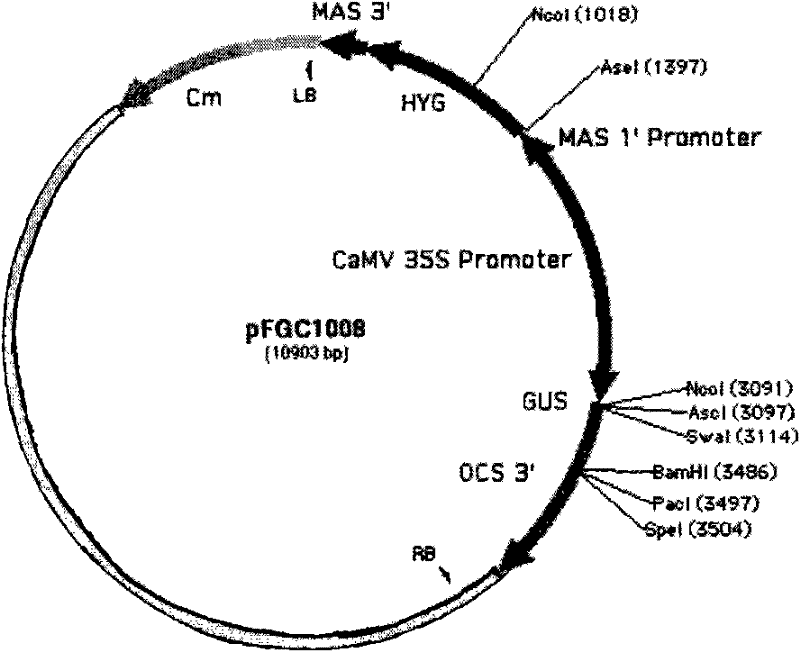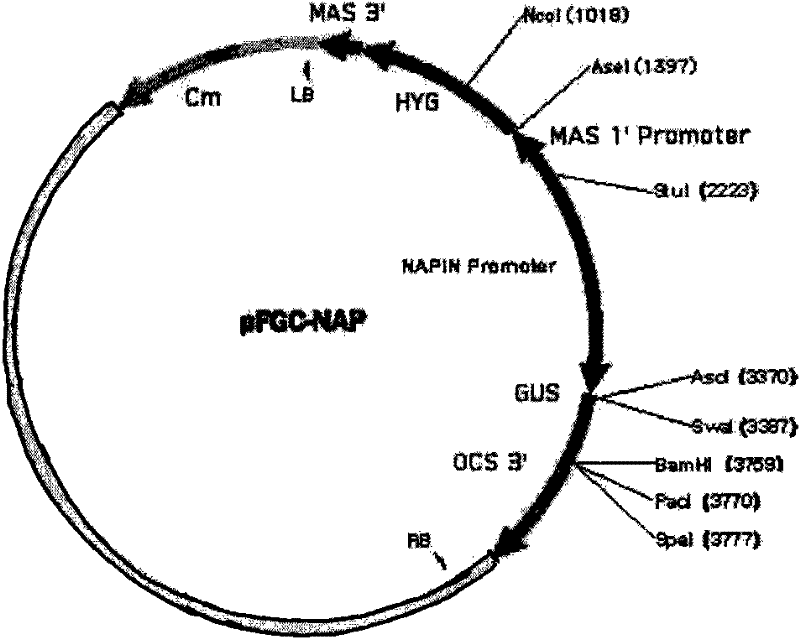Plasmid for constructing interference vector and construction method and application thereof
A technology for interfering vectors and plasmids, applied in the direction of using vectors to introduce foreign genetic material, applications, botanical equipment and methods, etc., can solve problems such as negative effects on plant growth and development, and achieve the effect of improving quality and high interference efficiency.
- Summary
- Abstract
- Description
- Claims
- Application Information
AI Technical Summary
Problems solved by technology
Method used
Image
Examples
Embodiment 1
[0022] Embodiment 1, construction of plasmid pFGC-NAP
[0023] 1. Preparation of seed-specific promoter fragments
[0024] 1. Extraction of Rapeseed Genomic DNA
[0025] The young leaves of rapeseed (Brassica napus variety Gaoyou 605; purchased from Zhejiang Fengqi Seed Industry Co., Ltd.) were taken, and genomic DNA was extracted with a plant genomic DNA extraction kit (catalogue number: DP320-02).
[0026] 2. PCR amplification of NAPIN gene promoter fragment
[0027] Using genomic DNA as a template, a pair of primers were designed (the 5' ends of the two primers were introduced into Stu I and Asc I restriction recognition sequences and protective bases, respectively).
[0028] Upstream primer S1: 5'-GA AGGCCT TCTTCATCGGTGATTGAT-3' (the underline is the Stu I recognition sequence);
[0029] Downstream primer S2: 5'-A GGCGCGCC TGTATGTTTTTAATCTTG-3' (Asc I recognition sequence is underlined).
[0030] PCR amplification was performed using the above primers. A PCR produ...
Embodiment 2
[0051] Embodiment 2, construction and application of interference carrier
[0052] Δ12 fatty acid desaturase (FAD2) is a key enzyme for plants to produce polyunsaturated fatty acids. FAD2-1 is specifically expressed in seeds during embryonic development and is considered to be the key enzyme responsible for further desaturation of oil in seeds. Inhibiting the FAD2-1 gene specifically expressed in cotton seeds by means of RNA interference can greatly reduce the production of linoleic acid and α-linolenic acid in cottonseed fatty acids, thereby increasing the content of oleic acid that is beneficial to production. Therefore, in this example, the plasmid pFGC-NAP constructed in Example 1 was used to construct an RNA interference expression vector using cotton FAD2-1 as an interference target gene.
[0053] 1. Preparation of target gene interference fragment
[0054] 1. Extraction of cotton total RNA
[0055] Cotton immature embryos (Kezimian 201, purchased from the Cotton Resea...
PUM
 Login to View More
Login to View More Abstract
Description
Claims
Application Information
 Login to View More
Login to View More - R&D
- Intellectual Property
- Life Sciences
- Materials
- Tech Scout
- Unparalleled Data Quality
- Higher Quality Content
- 60% Fewer Hallucinations
Browse by: Latest US Patents, China's latest patents, Technical Efficacy Thesaurus, Application Domain, Technology Topic, Popular Technical Reports.
© 2025 PatSnap. All rights reserved.Legal|Privacy policy|Modern Slavery Act Transparency Statement|Sitemap|About US| Contact US: help@patsnap.com



